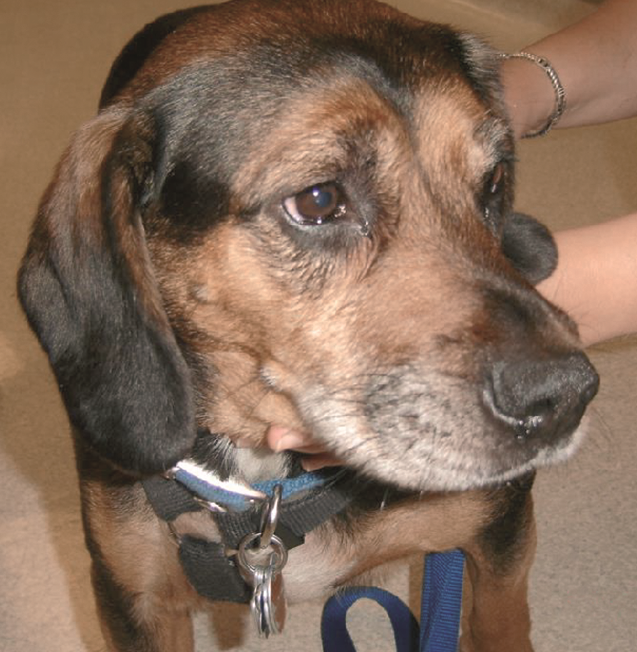Difference between revisions of "Small Animal Emergency and Critical Care Medicine: Self-Assessment Color Review, Second Edition, Q&A 17"
Jump to navigation
Jump to search
(Created page with "{{CRC Press}} {{Student tip |X = an approach to pain relief showing how to perform an epidural. }} <br><br><br> File:Small Animal Emergency and Critical Care Medicine 2E Q17...") |
|||
| (One intermediate revision by the same user not shown) | |||
| Line 24: | Line 24: | ||
[[Category:CRC Press flashcards]] | [[Category:CRC Press flashcards]] | ||
| − | To purchase the full text with your 20% | + | To purchase the full text with your 20% discount, go to the [https://www.crcpress.com/9781482225921 CRC Press] Veterinary website and use code VET18. |
| + | <br> <br> | ||
{{#tag:imagemap|Image:Next Question CRC Press.png{{!}}center{{!}}200px | {{#tag:imagemap|Image:Next Question CRC Press.png{{!}}center{{!}}200px | ||
| − | rect 0 0 860 850 [[Small Animal Emergency and Critical Care Medicine: Self-Assessment Color Review, Second Edition, | + | rect 0 0 860 850 [[Small Animal Emergency and Critical Care Medicine: Self-Assessment Color Review, Second Edition, Q&A 18|Next question]] |
desc none}} | desc none}} | ||
Latest revision as of 09:39, 26 November 2018
| This question was provided by CRC Press. See more case-based flashcards |

|
Student tip: This case is an approach to pain relief showing how to perform an epidural. |
A 5-year-old Beagle-cross is hospitalized with a working diagnosis of acute severe pancreatitis (144). During the morning rounds: T = 39.4°C (103°F); HR = 140 bpm; RR = 20 bpm; CRT = 2 sec; MM pale pink and moist. The dog is anorexic and showing signs of nausea and severe abdominal pain. The dog is currently receiving fentanyl (5 μg/kg/min CRI IV) for analgesia but does not appear to be receiving adequate pain control.
| Question | Answer | Article | |
| What additional options for pain control may be used in this dog? | In order of preference: (a) increasing the fentanyl infusion dose (up to 10 μg/kg/min); (b) additional analgesic infusions (e.g. ketamine [0.1–1 mg/kg/hr], lidocaine [25–80 μg/kg/min] and/or dexmedetomidine [1–5 μg/kg/min]) to the fenta-nyl; (c) change the opioid (e.g. hydromorphine, methadone); (d) epidural local analgesia (0.5–2.0 mg/kg of 7.5% bupivacaine); (e) peritoneal lavage and infusion of local anesthetic. NSAIDs are rarely used in animals with pancreatitis.
|
Link to Article | |
| Describe how to perform an epidural injection. | Need heavy sedation or GA. Sternal or lateral recumbency with hindlimbs ex-tended cranially. Clip and scrub the region over spinal processes of L6–S2. Ensure midline entry of needle by palpating wings of ilium; locate the space between L7 and S1. Insert a 20 or 22 gauge spinal needle directly on the midline, caudal to the dorsal process of L7, perpendicular to the spinal column. Several small ‘pops’ are felt passing through the ligamentum flavum, and a more pronounced ‘pop’ through the interarcuate ligament. Inject the drug without resistance and over 1–5 minutes.
|
Link to Article | |
| What medications are commonly administered in the epidural space for pain relief? | Local anesthetics (lidocaine 2% or bupivacaine 0.5% and preservative-free morphine (0.1–0.4 mg/kg; drug volume should not exceed 6 ml).
|
Link to Article | |
| What are some possible causes of the worsened nausea and abdominal pain in this dog? | Include: increasing pancreatic inflammation, peritonitis from ruptured pancreatic abscess or other cause, GI ulceration, organ torsion, dilation or ischemia, severe ileus, gallbladder distension or rupture, insufficient analgesia.
|
Link to Article | |
To purchase the full text with your 20% discount, go to the CRC Press Veterinary website and use code VET18.
